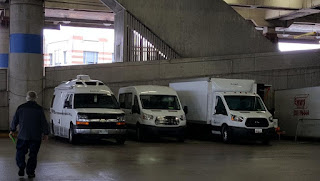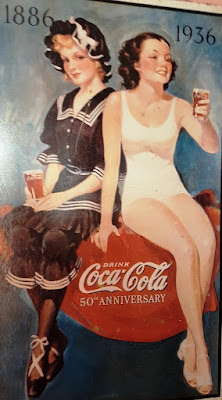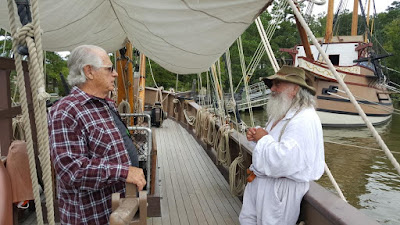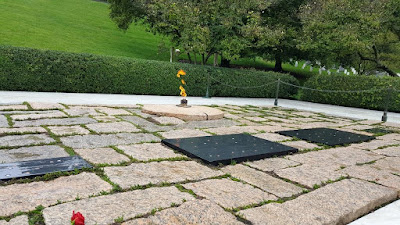Baltimore & Washington D.C.
Trip Report #5 September 22-24, 2018
Baltimore: Poe and Polish
Poland in Baltimore
Our travels to D.C. from Philly included a stop in Baltimore to visit Edgar Allan Poe. This was our only intended stop, however as we drove into downtown, we noticed multiple temporary signs touting pierogies at Holy Rosary. Well … it is lunchtime, we love pierogies and Holy Rosary is the name of our parish church at home in Colorado. We arrived at the beginning of the church’s annual Polish Festival. Another surprising connection is that right next door is a school – Cristo Rey Jesuit High School. Cristo Rey High Schools are a series of private schools across the nation with a unique mission … locate in an inner city, serve students in the lower economic strata, and provide them with entry level jobs once a week, in companies partnered with the school, to help pay for their tuition. The connection? Our daughter Wendy heads the English Department at Cristo Rey De La Salle North Catholic in Portland Oregon. (If you are intrigued, check them at their website online.)

Everyone spoke Polish; the people were super friendly; the food was homemade; we had grilled kielbasa, pirogues. The dessert, kremowka papieska is amazing (
translated “Polish Papal Cream Cake” because John Paul II mentioned he loved it.) … we had two each. The live music featured polkas and the people were dancing.
The church, Holy Rosary, built in 1928 and was stunning inside and out. It is also designated as the Divine Mercy Shrine. Serendipity transpires here … a great example of being open to the unexpected in our travels!


Edgar Allan Poe

We did get to see Poe’s house. Poe, a storyteller and poet who lived from 1809 to 1849 ... who dared to dream dreams no man ever dreamed before.

The house and the neighborhood is very peculiar ... as fitted this man. Set in a subsidized housing project with no tourist parking except curbside. Interesting that the blocks of housing all resembled the Poe house, using the same style and bricks. Nevertheless, worth visiting if you are a Poe fan … which we are.
Washington D.C.
There are no campsites for an RV, even our small one, in D.C. or even near it. We stayed in a KOA 28 miles north of the city that offered a shuttle out to the National Mall on Sunday.
This was our third visit, in our lives, to D.C. Therefore, we determine to visit those sites we had not seen before. We did purchase the two-day trolley tours around the city. The narrations are such fun and the hop-on, hop-off service is so convenient.
The first thing we did was go to Union Station. Union Station proves to be our center. That first day, we discovered a food court downstairs with reasonable prices
(two words not normally found in D.C.). There are dozens of restaurants and food counters in there. We even had some iconic pretzels.
Arlington Cemetery
Then we hopped on the trolley touring the city listening to the fascinating descriptions of everything we pass and making notes as to what to see the next day. The tour includes a swing out to Arlington Cemetery across the Potomac River into Virginia. We never even imagined the size of this place! There are 20 stops on the tour in the cemetery alone. Six hundred acres of rolling hills with the resting place of over 400,000 service members and their families as well as JFK and the Tomb of the Unknown Soldier … both of which we stopped visited.


The first military burial was in 1864. They estimate the last burial will be around 2030, with no more space left. Interestingly, this was the original property of confederate General Robert E. Lee. Lee married Mary Custis who was the great-granddaughter of George Washington. The home and property belonged to the Custis family. As they decided to side with the South they vacated the property at the beginning of the Civil war, as it was so close to Maryland and the North. Pictures here include JFK’s eternal flame at his grave site; the hills of the cemetery; the grave of the Unknown Soldier with the changing of the guard; and yes, it rained all day.



Lincoln Memorial
We then went to the Lincoln Memorial.
Afterward, on the trolley again and enjoyed the continuing tour, enjoying the entertaining chatter of the narrator with background information about the sites we went by. Then home on the campground shuttle to recuperate for the next day. And yes, it rained all day.

The next day we drove into D.C. and parked at Union Station, which has an entrance for buses, taxis and RVs on H Street. Therefore, with our Coyote safely stowed, we continue exploring.
We had a personal list of what to see. However, we only caught half of those on the list, even though we stayed until 8:00 p.m. These pictures reveal the highlights.
A tour of the
Capital Building, which houses the Senate and the House of Representatives.

The tour guide has a Master’s Degree in American History … most knowledgeable and a good speaker. One of the original painting in the rotunda is of the signing of the Declaration of Independence. In the previous blog, in the city of Philadelphia, I posted a picture of that room in Independence Hall.
The entire building reflect Roman architecture influences as well as does the art. Rome was the first culture to have a republic form of government.
 |
| In the rotunda dome ceiling, the various Roman gods. See G. Washington in center ring with lavender robe on his knees. |
 |
The original Senate Hall, now too small for 100 senators and
aides. Used for ceremonial stuff and photos. |
 A question for you. Why is the statue of the pioneers of women's suffrage unfinished ... as intended.
A question for you. Why is the statue of the pioneers of women's suffrage unfinished ... as intended.
The Library of Congress

You can get there through an underground tunnel without going through security again. This is our most favorite building … easily the most beautiful ... with marble on walls and ceilings, precious wood, and splendid floor tiles.

 |
| Library of Congress Research and Reading room. |


A walk through the
Botanic Gardens ... Genuinely an oasis and quiet place within such a busy city.
A visit to the
Hirschhorn Museum. This is an amusing place of contemporary art and culture, every artisan trying to tell his/her story.



Finally dinner at a quaint diner in Union Station …
Johnny Rocket’s.
Chesapeake Bay
A fan of Michener, I read his book “Chesapeake” many years ago and resolved to go there. We are on our way next.
Enormous, massive, engineering marvel bridges are not a common feature found in Colorado, so we are fascinated when we cross them here in the east. There are two such riveting bridges in the Chesapeake Bay Area. The
Chesapeake Bay Bridge near the north end of the bay east of D.C. and the
Chesapeake Bay Bridge-Tunnel south … near where the bay empties into the Atlantic.
Leaving D.C., we crossed the first one here – the Bay Bridge. Bridging the bay for a staggering 4.3 miles it is a double span,
curving bridge that opened in 1952. Certainly left an impression on us.
Next ... the Atlantic Ocean.








































































